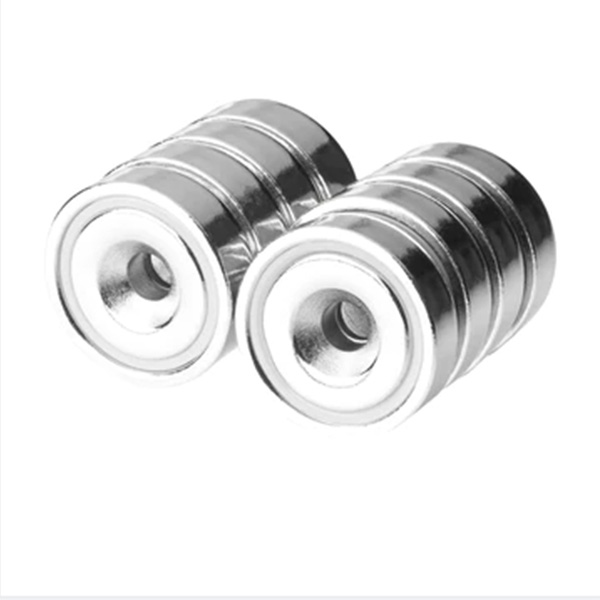
Pot magnets, also known as cup magnets or pot-shaped magnets, are magnets that have a concave shape on one side and a flat, disc-shaped base on the other side. They are called "pot magnets" because they are shaped like a pot or a cup.
Pot magnets are made by embedding a magnet in a steel cup or pot, which increases the magnetic force of the magnet and allows it to lift or hold more weight. Pot magnets are commonly used in a variety of applications, including holding signs or other objects in place, lifting and moving heavy objects, and providing a secure mounting point for machinery and equipment.
There are several features and advantages of pot magnets:
Enhanced magnetic force :
The steel cup or pot surrounding the magnet increases the magnetic force of the magnet, allowing it to lift or hold more weight.
Versatility:
Pot magnets can be used in a wide range of applications, including holding signs or other objects in place, lifting and moving heavy objects, and providing a secure mounting point for machinery and equipment.
Easy installation:
Pot magnets are easy to install and can be attached to a variety of surfaces using screws, bolts, or adhesive.
Durability:
Pot magnets are made from high-quality materials, such as neodymium iron boron, which makes them resistant to corrosion and wear.
Customization:
Pot magnets can be customized to meet specific requirements, such as size, shape, and magnetic strength.
Cost-effective:
Pot magnets are an affordable and cost-effective solution for applications that require a strong, versatile magnet.
We can custom manufacture Pot magnets to your exact specifications.
There are several steps involved in producing pot magnets:
Procurement of raw materials:
The first step in producing pot magnets is to obtain the raw materials, which include neodymium iron boron (NdFeB) or samarium cobalt (SmCo) magnet material and steel cups or pots.
Magnetic material preparation:
The magnet material is ground into a fine powder and mixed with a binding agent to form a slurry. The slurry is then poured into molds to create the desired shape of the magnet.
Sintering:
The magnet material is then sintered, or heated under pressure, to remove impurities and create a strong, dense magnet.
Coating:
The magnet is then coated with a protective layer to prevent corrosion and improve its durability.
Assembly:
The magnet is then placed into a steel cup or pot and secured in place using adhesive or a retaining ring.
Quality control:
The finished pot magnets are inspected to ensure they meet the required specifications and standards.
Pot magnets are available in a range of grades, which refer to the strength of the magnet material. The grade of a pot magnet is determined by the maximum energy product, or the maximum amount of magnetic energy that can be stored in the material.
Some common grades of neodymium pot magnets include:
Grade N35:
This is a medium-strength grade of NdFeB magnet material, with a maximum energy product of around 35 mega-gauss-oersteds (MGOe). It is suitable for lighter applications such as holding papers or small decorations on a fridge or whiteboard..
Grade N42:
This is a higher-strength grade of NdFeB magnet material, with a maximum energy product of around 42 MGOe. It is suitable for a wider range of applications, such as holding tools or light machinery in place.
Grade N52:
This is a high-strength grade of NdFeB magnet material, with a maximum energy product of around 52 MGOe. It is suitable for heavy-duty applications such as holding large machinery in place or supporting heavy loads.
Other grades, such as N38, N40, N45, N48, N50, N55 also be available. The specific grade of a button magnet will depend on the material and manufacturing process used to produce it.
Pot magnets are widely used in a variety of applications due to their versatility and strong holding power. Some common applications of pot magnets include:
Industrial applications :
Pot magnets are often used in industrial settings to hold tools, fixtures, or machinery in place. They are also used to secure heavy loads or to hold parts together during manufacturing processes.
Retail and signage applications :
Pot magnets are used in retail and signage applications to hold signs, posters, and other promotional materials in place.
Kitchen and home applications :
Pot magnets are used in the kitchen and home to hold tools, utensils, and other items in place. They are also used to hold decorations or other items on refrigerators or other metal surfaces.
Educational and office applications:
Pot magnets are used in classrooms and offices to hold papers, documents, and other materials on whiteboards or other metal surfaces.
Overall, pot magnets are a useful and practical tool in a wide range of applications due to their strong holding power and versatility.
Service every customer with care & professional.
Professional Production Base
AEMagnets is equipped with a complete set of advanced equipments and processing facilities in particular high standard cleaning room.
Strict Quality Control - ISO9001
We runs a strict quality control system involving raw materials selection, production control, product inspection, fine packing.
Timely and Attentive Service
We strive to provide fast and efficient service to meet your deadlines and provide full technical and after-sales service support.

